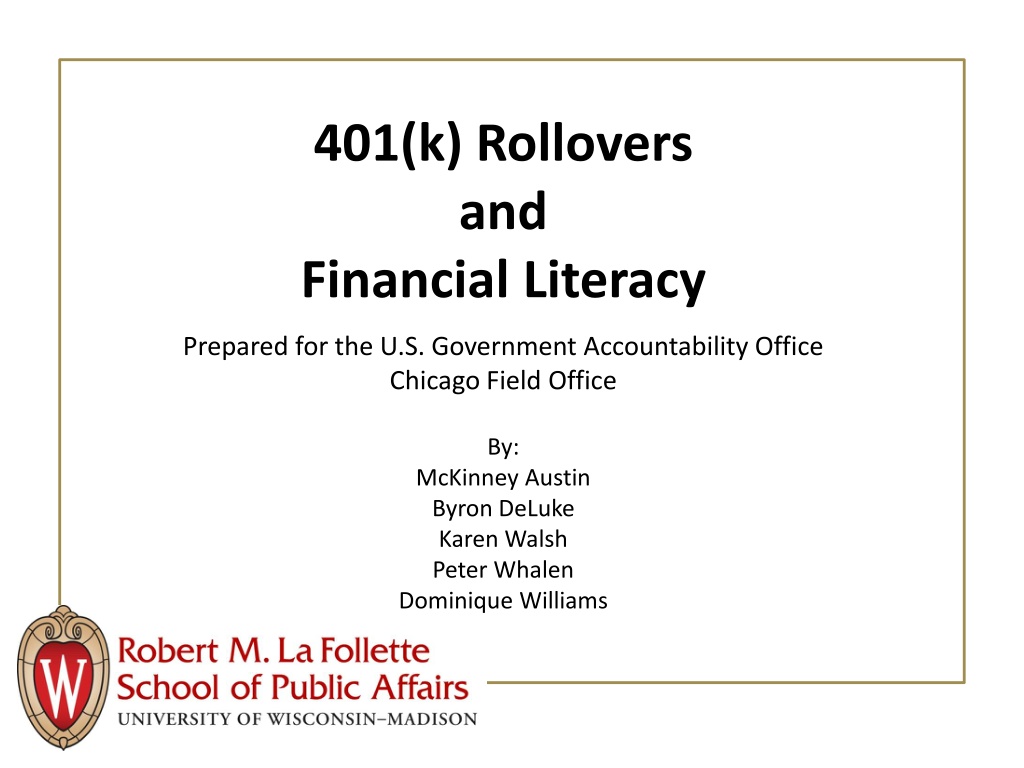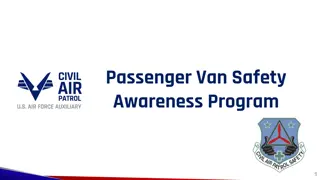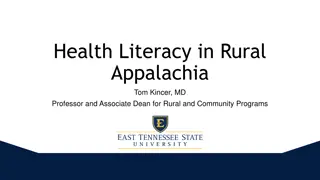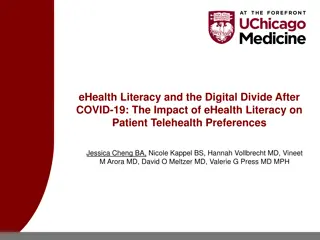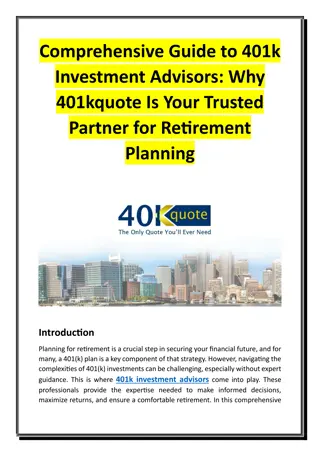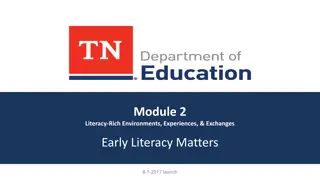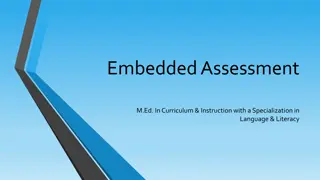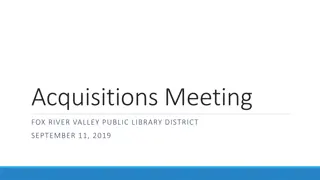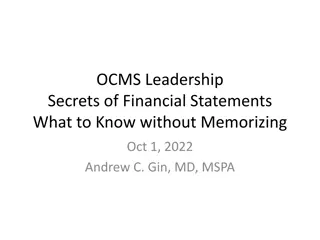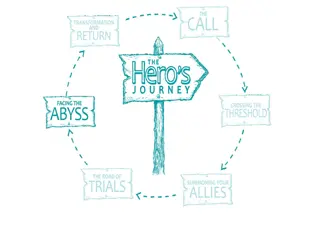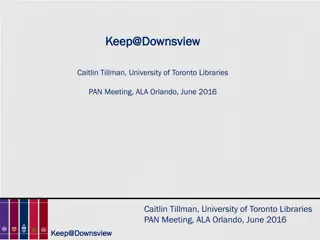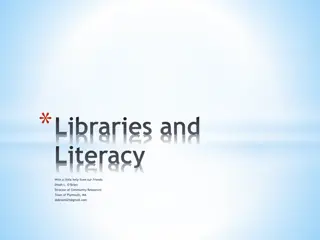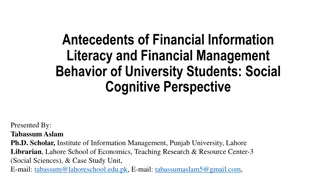401(k) Rollovers and Financial Literacy Research
The research conducted on 401(k) rollovers and financial literacy by McKinney Austin, Byron DeLuke, Karen Walsh, Peter Whalen, and Dominique Williams explores the changing retirement savings landscape in the US. It delves into the demographic characteristics of IRA holders, the impact of rollovers on IRA assets, awareness of fees, transparency in fee structures, and the relationship between financial literacy and rollover decisions. The study reviews available literature, interviews industry professionals, and analyzes data from the Health and Retirement Study (HRS).
Download Presentation

Please find below an Image/Link to download the presentation.
The content on the website is provided AS IS for your information and personal use only. It may not be sold, licensed, or shared on other websites without obtaining consent from the author.If you encounter any issues during the download, it is possible that the publisher has removed the file from their server.
You are allowed to download the files provided on this website for personal or commercial use, subject to the condition that they are used lawfully. All files are the property of their respective owners.
The content on the website is provided AS IS for your information and personal use only. It may not be sold, licensed, or shared on other websites without obtaining consent from the author.
E N D
Presentation Transcript
401(k) Rollovers and Financial Literacy Prepared for the U.S. Government Accountability Office Chicago Field Office By: McKinney Austin Byron DeLuke Karen Walsh Peter Whalen Dominique Williams
Background The retirement savings landscape has changed with increasing prevalence of defined contribution plans. U.S. workers have greater responsibility to prepare for retirement via savings and investments. 1
Background Increasingly, defined contribution plan accumulations are rolled into Individual Retirement Accounts (IRAs) Potentially higher IRA fees can lead to reduced accumulation, standard of living Broad cross section of U.S. population is impacted 2
Research Questions To what extent do U.S. workers own IRAs and what are the demographic characteristics of IRA holders? Are rollovers a significant source of IRA assets and who rolls over? Are individuals who roll over aware of the option to leave assets in 401(k)s? Are they aware of fees when rolling over? Are the fees transparent? What is the relationship between financial literacy and the rollover decision? 3
Research Methods Reviewed available literature Interviewed industry professionals Analyzed Health and Retirement Study (HRS) data 4
To What Extent Do U.S. workers Own IRAs? An increasing proportion of retirement savings are held in IRAs Both IRA ownership and rollover activity span many demographic groups Share of IRA assets increases with age 5
IRA Ownership: Percentage of U.S.-based Financial Retirement Assets in IRAs, 1985-2009 Year 1985 1990 1999 2005 2006 2007 2008 2009 10% 18 29 33 34 34 35 36 Percent in IRA Actual amount (trillions of 2009 dollars) $0.2 0.6 2.7 3.7 4.2 4.8 3.6 4.3 Note: All values are nominal. Retirement assets include IRAs, annuities, and employee-sponsored DB and DC plans Source: ICI, 2010. 6
Share of IRA Assets Increase to Age 70 50 40 Percent 30 20 10 0 25-29 30-39 40-49 Age Groups 50-59 60-69 70-74 Traditional IRA Investors Traditional IRA Assets held by Investors Source: ICI, 2010 7
What are the Demographic Characteristics of IRA Holders? IRA ownership increases with: Family income Educational attainment of the head of household Family net worth Ownership rates are highest for middle-age individuals Individuals age 60-69 account for the largest share of IRA assets Have worked for a long time; have not yet reached retirement age 8
Are Rollovers a Significant Source of IRA Assets and Who Rolls Over? U.S. workers change jobs with increasing frequency (Bureau of Labor Statistics) Vast majority of assets in traditional IRAs are from rollovers 2007: approximately 5% from contributions Rollovers Almost even across age groups Like IRA ownership, spread across demographic groups Unlike IRA ownership, no strong correlation with income 9
Employee Options upon Separation Keep account assets in the employer s plan Rollover account assets to an IRA Invest the account assets in the new employer s 401(k) Withdraw the account assets Annuitize the account assets 10
Option Selection According to Charles Schwab data, of the distributed 401(k) assets under their management: 80% were rolled over into an IRA 10% were taken as cash 8% were moved into a new employer s 401(k) 2% were taken in other forms of distribution 11
Are Individuals Aware of Options at Separation? Are 401(k) participants aware of their options upon separation from the employer? The plan must provide participants with information about their rights and benefits, including rollover options Do participants read the provided information? Our interviews suggest the answer is no 12
Factors Affecting the Rollover Decision Are individuals aware of IRA and 401(k) fees? What other factors might individuals consider when facing the rollover decision? 13
Are Individuals Aware of 401(k) and IRA Fees? Research suggests that about half of employed persons cannot identify their type of pension or plan An even higher portion are unaware of any associated fees This is critical because higher fees relate directly to lower returns 14
Are 401(k) and IRA Fees Transparent? Many 401(k) participants mistakenly believe the employer pays the fees Factors affecting fees paid: Amount invested in the account Terms negotiated between sponsor and provider Many providers bundle funds and/or administrative fees and fund expenses 15
New 401(k) Disclosure Rule New DOL rule goes into effect November 1, 2011 Under new rule, annual statement must including: Administrative and individual services fees Performance after fees are subtracted Amount and description of investment fees Total annual operating expenses Statement about cumulative effect of fees on account growth 16
Relative Importance of Fees in the Rollover Decision Other considerations: Investment options within plans 10% premature distribution penalty Tax treatment: employer stock Disposition at death Interviews suggest that investment options and customizability are primary rollover factor 17
What is the Relationship Between Financial Literacy and Rollovers? Does financial literacy affect rollover decision? Financial literacy Knowledge and capacity required to effectively manage one s long-term financial health Evidence suggests ambiguous relationship 18
Data: Health and Retirement Study (HRS) HRS is a national, longitudinal dataset managed by the University of Michigan Captures information from biennial interviews of over 22,000 Americans ages 50 and older Provides information about rollovers into IRAs 19
HRS Financial Literacy Questions If the chance of getting a disease is 10%, how many people out of 1,000 would be expected to get the disease? If 5 people all have the winning number in the lottery and the prize is 2 million dollars, how much will each of them get? Let s say you have 200 dollars in a savings account. The account earns 10% interest per year. How much would you have in the account at the end of two years? 20
Defining the Sample Use respondent-level core data from 2006 Include information from respondents who: Left an employer since 2004 Had a DC plan Took only one action on their primary DC plan Rolled over to IRA, left assets in DC account, or withdrew Total sample size of 375 respondents 21
Sample Breakdown 89 154 respondents withdrew respondents left in account 132 respondents rolled over 22
Demographic Characteristics of the Sample ? Left? in? account? 60? 53? 66? Rolled? over? 61? 52? 74? Withdrew? Mean? age? ? Female? (percent)? Married? (percent)? Household? income? below? the? poverty? line? (percent)? ? ? ? ? ? ? ? ? ? ? ? ? Race? White/Caucasian? (percent)? Black/African? American? (percent)? Hispanic? (percent)? 60? 58? 60? 6? 3? 9? ? ? ? 81? 12? 6? 87? 7? 5? 67? 15? 12? ? 23
Methods for Analysis Compared correct response rates to financial literacy questions and education levels of those who rollover to: Those who left assets in DC plans, and Those who withdrew assets altogether T-tests used to test whether groups are significantly different 24
Limitations Small sample size Analysis does not control for other factors Results specific to sample population Financial literacy measures may not reflect knowledge required for rollover decision 25
Results Financial literacy and education levels are not significantly different between respondents who rolled assets into IRAs and respondents who left assets in their DC accounts Financial literacy and education levels are significantly higher for respondents who rolled assets into IRAs than respondents who withdrew assets 26
Correct response rates not statistically different between respondents who rolled over or left assets in DC accounts 100 85.8 Rolled over Left in account 90 Correct response rate 81.0 80 70 59.9 57.9 60 50 40 30 19.4 17.1 20 10 0 Q1 (disease) Q2 (lottery) Q3 (interest) Financial literacy question 27
Education levels not statistically different between respondents who rolled over or left assets in DC accounts 16 14.1 14.0 14 Average years of 12 education 10 8 6 4 2 0 Rolled over Left in account 28
Correct response rates significantly higher for respondents who rolled over assets than respondents who withdrew assets 100 85.8 Correct response rate 90 Rolled over 80 69.3 Withdrew 70 57.9 60 43.7 50 40 30 17.1 11.9 20 10 0 Q1*** (disease) Q2** (lottery) Q3 (interest) Financial literacy question Significance levels: *** = 1 percent; ** = 5 percent 29
Education levels significantly higher for respondents who rolled over assets than respondents who withdrew assets 16 14.1 Average years of 14 12.2 12 education 10 8 6 4 2 0 Rolled over Withdrew Significance level = 1 percent 30
Discussion Financial literacy measures capture useful information Results consistent with literature and interviews Individuals may be: Unaware of fees Considering factors other than fees Ambiguous relationship between financial literacy and investment decisions 31
Conclusion IRAs are an important, growing source of retirement wealth. This issue applies to a significant number of individuals in the U.S. and cuts across demographic sectors. Basic measures of financial literacy (education levels, arithmetic skills) are not able to differentiate people who roll assets into IRAs rather than leave them in their DC accounts. 32
Recommendations Conduct further research on the outcomes of rollovers from a total wealth perspective Evaluate new financial disclosure requirements Address potential conflicts of interest among financial service providers offering rollovers to IRAs Determine whether withdrawal behavior warrants further study 33
Thank you! To access the full report, please visit: http://www.lafollette.wisc.edu/publications /workshops.html
Correct response rates and education levels not statistically different between respondents who rolled over or left assets in DC accounts Variables Rollover to IRA Assets left in account % Correct 81.0 (3.2) p-value % Correct Obs. 85.8 (3.1) Obs. 147 Financial literacy Q1 127 0.142 Financial literacy Q2 57.9 (4.4) 126 59.9 (4.1) 147 0.374 Financial literacy Q3 17.1 (3.6) 111 19.4 (3.5) 129 0.327 Mean 14.1 (0.2) Obs. 131 Mean 14.0 (0.2) Obs. 154 Years of education 0.347 Standard deviations in parentheses. P-values provided for one-tailed tests.
Correct response rates and education levels significantly higher for respondents who rolled over assets than respondents who withdrew assets Variables Rollover to IRA % Correct 85.8 (3.1) Assets withdrawn p-value % Correct Obs. 69.3 (4.9) Obs. 127 Financial literacy Q1 88 0.002 Financial literacy Q2 57.9 (4.4) 126 43.7 (5.3) 87 0.020 Financial literacy Q3 17.1 (3.6) 111 11.9 (4.0) 67 0.177 Mean 14.1 (0.2) Obs. 131 Mean 12.2 (0.4) Obs. 89 Years of education 0.000 Standard deviations in parentheses. P-values provided for one-tailed tests.
